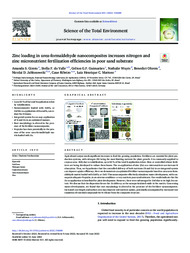Zinc loading in urea-formaldehyde nanocomposites increases nitrogen and zinc micronutrient fertilization efficiencies in poor sand substrate.
Zinc loading in urea-formaldehyde nanocomposites increases nitrogen and zinc micronutrient fertilization efficiencies in poor sand substrate.
Author(s): GIROTO, A. S.; VALLE, S. F. do; GUIMARÃES, G. G. F.; WUYTS, N.; OHREM, B.; JABLONOWSKI, N. D.; RIBEIRO, C.; MATTOSO, L. H. C.
Summary: Agricultural output needs significant increases to feed the growing population. Fertilizers are essential for plant production systems, with nitrogen (N) being the most limiting nutrient for plant growth. It is commonly supplied to crops as urea. Still, due to volatilization, up to 50 % of the total N application is lost. Slow or controlled release fertilizers are being developed to reduce these losses. The co-application of zinc (Zn) as a micronutrient can increase N absorption. Thus, we hypothesize that the controlled delivery of both nutrients (N and Zn) in an integrated system can improve uptake efficiency. Here we demonstrate an optimized fertilizer nanocomposite based on urea:urea-formaldehyde matrix loaded with ZnSO4 or ZnO. This nanocomposite effectively stimulates maize development, with consequent adequate N uptake, in an extreme condition ? a very nutrient-poor sand substrate. Our results indicate that the Zn co-application is beneficial for plant development. However, there were advantages for ZnO due to its high Zn content. We discuss that the dispersion favors the Zn delivery as the nanoparticulated oxide in the matrix. Concerning maize development, we found that root morphology is altered in the presence of the fertilizer nanocomposite. Increased root length and surface area may improve soil nutrient uptake, potentially accompanied by increased root exudation of essential compounds for N release from the composite structure.
Publication year: 2022
Types of publication: Journal article
Unit: Embrapa Instrumentation
Keywords: Controlled-release, Fertilizer, Nitrogen losses, Urea-formaldehyde
Observation
Some of Embrapa's publications are published as ePub files. To read them, use or download one of the following free software options to your computer or mobile device. Android: Google Play Books; IOS: iBooks; Windows and Linux: Calibre.
Access other publications
Access the Agricultural Research Database (BDPA) to consult Embrapa's full library collection and records.
Visit Embrapa Bookstore to purchase books and other publications sold by Embrapa.

